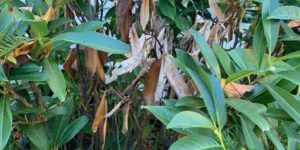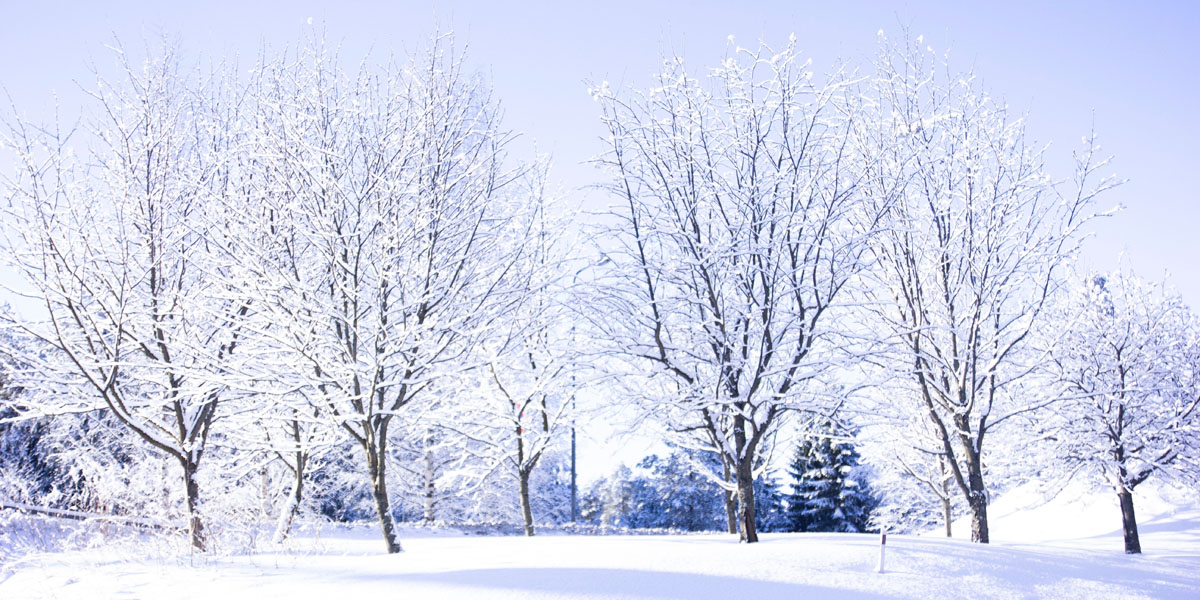As fall arrives, your garden starts winding down from its summer peak and winter dormancy is on the far horizon. Your trees are storing energy for winter, and it won’t be long before their leaves turn color and begin to drop.
While the year’s work of your trees and shrubs is almost done, you’ve still got work to do! Read on to learn about what you can do for your trees this fall.
Water Is Still Important
Avoid Stress
Even if your deciduous trees are going to drop their leaves, you’ll want to keep them from becoming stressed from heat and lack of water. Both heat stress and drought stress will damage a tree’s roots and internal system, so don’t risk their long-term health – or the brilliant fall color we all love. Stressed trees are more likely to have leaf damage and stressed deciduous tree leaves can brown and drop early instead of displaying brightly-colored foliage.
Keep Watering
If there’s no rain, and if temperatures stay warm, continue watering your trees.
If we have a hot and dry fall, you’ll want to keep your trees irrigated and wait until cool weather and regular rainfall to turn off your irrigation system.
Continue watering your trees into the fall if:
- Rainfall hasn’t started or isn’t regularly occurring
- Days are still warm or hot
- Nights are cool but there has not been a freeze
- Soil still has stored warmth and can easily absorb and hold water
As the days shorten, temperatures cool, and rain becomes more prevalent, your trees will start shutting down for winter. Once this happens, you can drain your garden hoses and turn off your irrigation system (don’t forget to blow out any remaining water in the system!).
It’s Time to Plant!
Choose Wisely
If you’re planning on adding a new tree to your garden this fall, be sure that you’re choosing a species that is best suited for our climate and for your property. Choosing a tree that is native or adapted to New Jersey’s climate and soils is the best way to ensure its long-term health. A tree that’s naturally vigorous and healthy is more resistant to pests and diseases, will look better, and will require less care.
- Want reliable fall color? Choose a new tree from our list of trees that have the best fall color!
- Prefer to plant native trees? Check out Rutgers’ list of native trees and plants!
Whichever species you choose, congratulate yourself on adding another tree to your neighborhood and providing more habitat and winter shelter for birds and wildlife. Trees provide so many benefits for us all, as well as the surrounding environment.
Plant it in the Right Location
Just because we want a tree or shrub to grow in a specific spot doesn’t mean that it’s a good idea to plant it there! Before planting, make sure you understand the tree’s requirements for sunlight, soil type, drainage, and watering.
Most of all, be clear about the mature size of the tree; it’s often much bigger than you might expect. And it’s not just the growth you see above ground that’s important; roots take up a lot of space and can do extensive damage if a tree is poorly sited. A tree that’s the right size for its location will require less pruning over its lifespan, saving you money and causing the tree less stress.
Keep Close Watch on Newly-Planted Trees
While you’re waiting for colder weather, be ready to give your trees some extra help, especially if you have newly-planted or young trees. The trees that you planted last fall or this spring have small, underdeveloped root systems which means they have a limited range for finding water and nutrients. It’s your young trees that will be most affected by water stress and whose long-term growth can be stunted from heat and drought, so don’t skimp on the TLC.
For details, see our article on how to care for a newly-planted tree >>
Just Say No
Stop Fertilizing in Late Fall
Fall is when your garden and trees are preparing to “shut down” for the winter (this is known as dormancy). To allow them to enter dormancy in good health, you’ll want to stop fertilizing them in late fall, especially with nitrogen-heavy fertilizers.
Fertilizers heavy in nitrogen and phosphorus stimulate your trees to make new green leaves and buds. This is a natural response, but it’s not a good idea to encourage new growth late in the fall.
Your trees have been storing energy reserves for winter; giving them nitrogen or phosphorus fertilizer means they will draw on those stored energy reserves to push out new leaves. Any new growth that your trees make in fall will be killed by the first freeze, and all the energy your trees used to produce those leaves will be wasted.
Forcing new growth late in the autumn season takes away critical energy that your trees need to survive dormancy and to restart their growth next spring.
Then again, early fall fertilization (September and October) can give your trees the extra nutrients they may need to survive winter in good health. The key is to provide fertilizer before tree leaves start to change color and drop.
Stop Procrastinating
While your list of fall garden tasks may look daunting, if you make a schedule and start early you can tackle them one by one instead of in a last-minute rush. Here’s what we recommend you do:
- Clean up falling leaves regularly, and rake up debris such as fallen twigs and fruit or cones. Turn your compost pile (if you have one), and add this green waste, or collect your leaves for pick up. Always toss in the garbage any diseased garden waste that might have fungal spores, bacteria, or destructive insects instead of giving them a chance to overwinter and emerge next spring.
- Add compost around your trees’ dripline. Compost will slowly break down over the winter and enrich the soil without stimulating growth. This means that when your trees emerge from dormancy, their roots will find nutrients within easy reach to support new leaves and flowers.
- Top up mulch around your trees. Since it’s organic matter, wood chip mulch will break down into the soil and so needs to be regularly replenished. Among the important benefits of mulch is its ability to insulate and regulate soil temperature. This insulation will protect your trees’ fine feeder roots from winter’s freezing temperatures. For the best results, add organic wood mulch atop that layer of compost.
- Examine your trees for pests. If you find egg cases or insect larvae that are planning on overwintering, destroy them and discard their remains in the garbage. This ensures they won’t have a chance to hatch in the spring and begin eating your garden. For example, fall is when female Spotted Lanternflies lay their eggs (the eggs will hatch next May) so this is a good time to scout for egg masses and scrape them off!
- Check your trees for damage. Look for overgrown, cracked, split, hanging, or rotten branches and make a note of them so you’ll know which branches to remove after the tree has entered dormancy. Damaged areas can break or fall off under heavy snow or ice loads, or during winter storms.
Don’t Prune Yet
You’ll want to wait till winter dormancy to do any major pruning (unless there are tree branches that pose an immediate hazard – those should always be removed as soon as you notice them). Like late fall fertilization, pruning in fall can stimulate new growth that is easily killed when cold weather arrives and depletes the tree’s important energy reserves.
Learn about the benefits of pruning in winter >>
Bundle Up
Much the same way as we get out our winter wardrobes when cooler weather begins, fall is a good time to prepare your winter tree protection materials. Burlap wraps and wire mesh will protect your trees and shrubs over the coming winter from:
- Freezing temperatures that make trees brittle and can crack bark
- Road salt dissolved in rainwater, or melted ice that can burn evergreen leaves and increase damaging soil salinity
- Foraging winter animals that will gnaw on tree bark and tree roots
Wrap your trees after temperatures cool and spray irrigation is turned off; you don’t want layers of burlap to trap moisture and encourage fungal growth up against trunks, branches, or evergreen foliage. But aim to complete your winter tree protection tasks before the ground freezes or temperatures drop below freezing. And don’t forget to remove wraps before the temperatures rise and the ice melts in spring.
Check our winter tree care tips so you’ll be prepared for what’s coming up!
Need a Hand?
If you need a hand with your trees, we’re experienced and ready to help.
We offer winter pruning and trimming to keep your trees growing well, and we’ll also help you out if a winter storm brings down branches–large or small ones.







